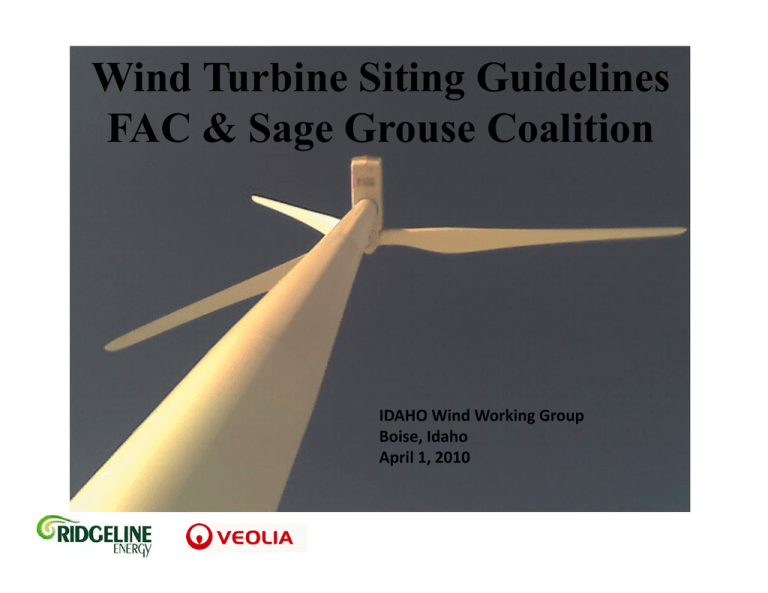Wind Turbine Siting Guidelines FAC & Sage Grouse Coalition IDAHO Wind Working Group Boise, Idaho
advertisement

Wind Turbine Siting Guidelines FAC & Sage Grouse Coalition IDAHO Wind Working Group Boise, Idaho April 1, 2010 • • • • • • • Ridgeline started in 2000 Developed 65 MW Wolverine Creek Wind Farm E of Idaho Falls Signed a power purchase agreement with Southern California Edison in April, awaiting Cal PUC approval, plan to build 90‐130 MW in 2010. 50% joint venture with BP 200 MW project South of Laramie – likely next project to see construction Now Ridgeline is wholly owned by Veolia Environmental Headquartered in Seattle with Offices in Boise, Portland, Idaho Falls, Spokane, FACA, NWCC, Sage Grouse Collaborative, Governor Otter’s Wind task Force, 2007 Governor’s Renewable Energy Award, 2 WIND SITE PROSPECTING CONCERNS Post‐Altamont Higher Scrutiny Archaeological/Cultural T&E, Candidate, Species of Interest • Large Intact Habitat • Pristine Sensitive Habitat • • • • • Habitat for Species of Habitat Fragmentation Concern Junction of I‐15 & 1‐86 in Pocatello 4 EASE OF PERMITTING and LIKELIHOOD OF OPPOSITION Wind Turbine Siting Guidelines Federal Advisory Committee Federal Caucus Mr. David J. Stout Chairman, U.S. Fish & Wildlife Service Mr. Steve Lindenberg U.S. Department of Energy Dr. Robert Robel Kansas State University State/Tribal Caucus Ms. Kathy Boydston TX Parks & Wildlife Department Mr. Scott Darling VT Fish & Wildlife Department Chairman Karen Douglas CA Energy Commission Mr. Greg Hueckel WA Department of Fish & Wildlife Ms. Jeri Lawrence Blackfeet Nation Mr. Mark Sinclair Clean Energy States Alliance Mr. Keith Sexson Assn. of Fish & Wildlife Agencies NGO Caucus Dr. Taber Allison Massachusetts Audubon Dr. Ed Arnett Bat Conservation International Mr. Mike Daulton National Audubon Society Ms. Aimee Delach Defenders of Wildlife Mr. Robert Manes The Nature Conservancy, KS Industry Caucus Mr. Michael Azeka AES Wind Generation Ms. René Braud Horizon Wind Energy Mr. Andrew O. Linehan Iberdrola Renewables Ms. Winifred Perkins NextEra Energy Resources Mr. Steven Quarles Crowell & Moring LLP Mr. Rich Rayhill Ridgeline Energy, LLC Mr. Patrick D. Traylor Hogan & Hartson, LLP 6 Tiered Approach: Tier 1 Preliminary desktop evaluation or screening of potential sites • Internal company process to: – Conduct landscape‐level review – Identify high risk/value habitats • Especially for ESA T&E, candidates, species of concern – Evaluate potential wildlife concerns – Find as many red flags as possible – No “boots on the ground” 7 Tiered Approach: Tier 2 • Analysis Overview: – The tiered process directs the developer to: • Avoid and/or minimize adverse impacts • Mitigate unavoidable significant adverse impacts • Decision Overview: – Risks are considered unacceptable: Abandon – Risks are low: discontinue Tiered approach and proceed toward construction – Risks are unknown: continue tiered process (either by continued analysis in present tier or in next tier) 8 Tiered Approach: Tier 3 Field studies to document site wildlife conditions and predict project impacts • Quantitative, scientifically rigorous studies to: – Use findings of prior Tiers to comprehensively Evaluate site for presence, use, seasonality, potential for impacts – Design site to avoid or minimize impacts – Evaluate need for post‐construction studies – Provide pre‐construction component of Tier 5 studies 9 Tier 3, Continued • Analysis Overview: – Who’s there? When? Why? In what numbers? – Are they likely to be adversely impacted by a wind farm? – If so, can adverse impacts be avoided? Minimized? – If impacts can’t be avoided/minimized are they significant? • ESA T&E or candidate; species of concern? • Significant on population level? (even local?) • Other? – Can significant adverse impacts be Mitigated? • Methods/Metrics • AWWI 10 Complex analytical Model 11 Construction BMPs Construction BMPS (Part D) inserted between Tier 3 and 4 because that’s when construction occurs 12 Tiered Approach: Tier 4 Post‐construction fatality studies • Generally recommended for finding of “Due Care” regardless of Tiered analysis indications • Estimation and study of: – Species composition of fatalities – Relationships of fatalities w/ site characteristics – Comparison among facilities – Comparison of actual & predicted fatalities • Are corrective management or mitigation measures warranted? 13 Tiered Approach: Tier 5 Other post‐construction studies • Direct and indirect effects – Displacement due to habitat alteration, loss, and/or fragmentation – Factors associated with effects • Effectiveness of measures to avoid, minimize, and mitigate • Local population demographic effects 14 NWCC Wind/Wildlife Sage Grouse Committee National Wind Coordinating Collaborative Sage Grouse Research Collaboration STEERING COMMITTEE ¾ Industry – – – – – ¾ State Agencies – – – – ¾ Dave Naugle, University of Montana Jim SedingerUniversity of Nevada Technical Monitor – • Zachary Bowen, U.S. Geological Survey Robin Sell, Bureau of Land Management Christy Johnson‐Hughes, USFWS Scientific/Academic – – ¾ Kevin Doherty, Audubon Wyoming Joe Kiesecker, The Nature Conservancy Federal Agencies – – – ¾ John Emmerich, Wyoming Game & Fish Scott Gardner, California Fish and Game Tom Hemker, Idaho Fish and Game Holly Michael, Oregon Fish and Wildlife NGOs – – ¾ Lin Alder, Wasatch Wind Christina Calabrese, Horizon Wind Energy Matt Grant, Rocky Mountain Power Nichole Hughes, RES Americas Rich Rayhill, Ridgeline Energy, LLC Karin Sinclair, National Renewable Energy Laboratory Facilitation Team – – Abby Arnold, Kearns & West Jennifer Bies, Kearns & West Rich Rayhill, Vice President Ridgeline Energy, LLC 720 W Idaho #36 Boise, ID 83702 (208) 841‐5037 rrayhill@rl‐en.com







